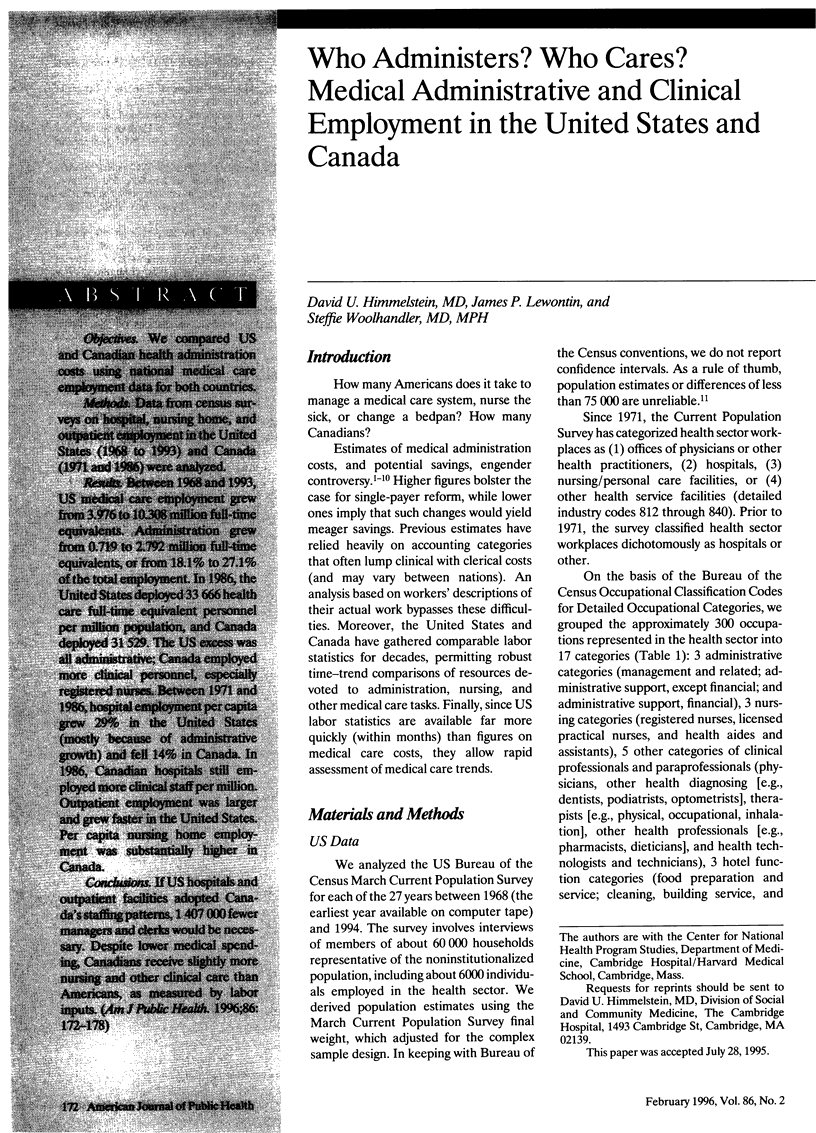Abstract
OBJECTIVES. We compared US and Canadian health administration costs using national medical care employment data for both countries. METHODS. Data from census surveys on hospital, nursing home, and outpatient employment in the United States (1968 to 1993) and Canada (1971 and 1986) were analyzed. RESULTS. Between 1968 and 1993, US medical care employment grew from 3.976 to 10.308 million full-time equivalents. Administration grew from 0.719 to 2.792 million full-time equivalents, or from 18.1% to 27.1% of the total employment. In 1986, the United States deployed 33,666 health care full-time equivalent personnel per million population, and Canada deployed 31,529. The US excess was all administrative; Canada employed more clinical personnel, especially registered nurses. Between 1971 and 1986, hospital employment per capita grew 29% in the United States (mostly because of administrative growth) and fell 14% in Canada. In 1986, Canadian hospitals still employed more clinical staff per million. Outpatient employment was larger and grew faster in the United States. Per capita nursing home employment was substantially higher in Canada. CONCLUSIONS. If US hospitals and outpatient facilities adopted Canada's staffing patterns, 1,407,000 fewer managers and clerks would be necessary. Despite lower medical spending, Canadians receive slightly more nursing and other clinical care than Americans, as measured by labor inputs.
Full text
PDF






Selected References
These references are in PubMed. This may not be the complete list of references from this article.
- Blumenthal D. Administrative issues in health care reform. N Engl J Med. 1993 Aug 5;329(6):428–429. doi: 10.1056/NEJM199308053290612. [DOI] [PubMed] [Google Scholar]
- Detsky A. S., Stacey S. R., Bombardier C. The effectiveness of a regulatory strategy in containing hospital costs. The Ontario experience, 1967-1981. N Engl J Med. 1983 Jul 21;309(3):151–159. doi: 10.1056/NEJM198307213090306. [DOI] [PubMed] [Google Scholar]
- Ellwood P. M., Jr, Anderson N. N., Billings J. E., Carlson R. J., Hoagberg E. J., McClure W. Health maintenance strategy. Med Care. 1971 May-Jun;9(3):291–298. doi: 10.1097/00005650-197105000-00008. [DOI] [PubMed] [Google Scholar]
- Fuchs V. R., Hahn J. S. How does Canada do it? A comparison of expenditures for physicians' services in the United States and Canada. N Engl J Med. 1990 Sep 27;323(13):884–890. doi: 10.1056/NEJM199009273231306. [DOI] [PubMed] [Google Scholar]
- Haber S. G., Zwanziger J., Anderson J. G., Thorpe K. E., Newhouse J. P. Hospital expenditures in the United States and Canada: do hospital worker wages explain the differences? J Health Econ. 1992 Dec;11(4):453–465. doi: 10.1016/0167-6296(92)90016-t. [DOI] [PubMed] [Google Scholar]
- Hiles D. R. Health services: the real jobs machine. Mon Labor Rev. 1992 Nov;115(11):3–16. [PubMed] [Google Scholar]
- Hilsenrath P. E., Levey S., Weil T. P., Ludke R. Health services management manpower and education: outlook for the future. J Health Adm Educ. 1993 Summer;11(3):407–419. [PubMed] [Google Scholar]
- Himmelstein D. U., Woolhandler S. Bias in, bias out: a reply to Sheils, Young, and Rubin. Health Aff (Millwood) 1992 Summer;11(2):235–238. doi: 10.1377/hlthaff.11.2.235-a. [DOI] [PubMed] [Google Scholar]
- Himmelstein D. U., Woolhandler S. Cost without benefit. Administrative waste in U.S. health care. N Engl J Med. 1986 Feb 13;314(7):441–445. doi: 10.1056/NEJM198602133140710. [DOI] [PubMed] [Google Scholar]
- Miller R. H. Containing use and expenditures in publicly insured long-term care programs. Health Care Financ Rev. 1993 Summer;14(4):181–207. [PMC free article] [PubMed] [Google Scholar]
- Paton S., Lobin T. Nursing in Canada--1991. Health Rep. 1992;4(3):321–329. [PubMed] [Google Scholar]
- Schwartz W. B., Mendelson D. N. Eliminating waste and inefficiency can do little to contain costs. Health Aff (Millwood) 1994 Spring;13(1):224–238. doi: 10.1377/hlthaff.13.1.224. [DOI] [PubMed] [Google Scholar]
- Sheils J. F., Young G. J., Rubin R. J. O Canada: do we expect too much from its health system? Health Aff (Millwood) 1992 Spring;11(1):7–20. doi: 10.1377/hlthaff.11.1.7. [DOI] [PubMed] [Google Scholar]
- Shulkin D. J., Hillman A. L., Cooper W. M. Reasons for increasing administrative costs in hospitals. Ann Intern Med. 1993 Jul 1;119(1):74–78. doi: 10.7326/0003-4819-119-1-199307010-00012. [DOI] [PubMed] [Google Scholar]
- Thorpe K. E. Inside the black box of administrative costs. Health Aff (Millwood) 1992 Summer;11(2):41–55. doi: 10.1377/hlthaff.11.2.41. [DOI] [PubMed] [Google Scholar]
- Weil T. P. Clinton's health reform and emergency department volumes: a return visit. Ann Emerg Med. 1993 May;22(5):852–854. doi: 10.1016/s0196-0644(05)80804-2. [DOI] [PubMed] [Google Scholar]
- Weil T. P., Stack M. C. Health reform--its potential impact on hospital nursing service. Nurs Econ. 1993 Jul-Aug;11(4):200–204. [PubMed] [Google Scholar]
- Woolhandler S., Himmelstein D. U., Lewontin J. P. Administrative costs in U.S. hospitals. N Engl J Med. 1993 Aug 5;329(6):400–403. doi: 10.1056/NEJM199308053290606. [DOI] [PubMed] [Google Scholar]
- Woolhandler S., Himmelstein D. U. The deteriorating administrative efficiency of the U.S. health care system. N Engl J Med. 1991 May 2;324(18):1253–1258. doi: 10.1056/NEJM199105023241805. [DOI] [PubMed] [Google Scholar]
- Zelman W. A. The rationale behind the Clinton health care reform plan. Health Aff (Millwood) 1994 Spring;13(1):9–29. doi: 10.1377/hlthaff.13.1.9. [DOI] [PubMed] [Google Scholar]


